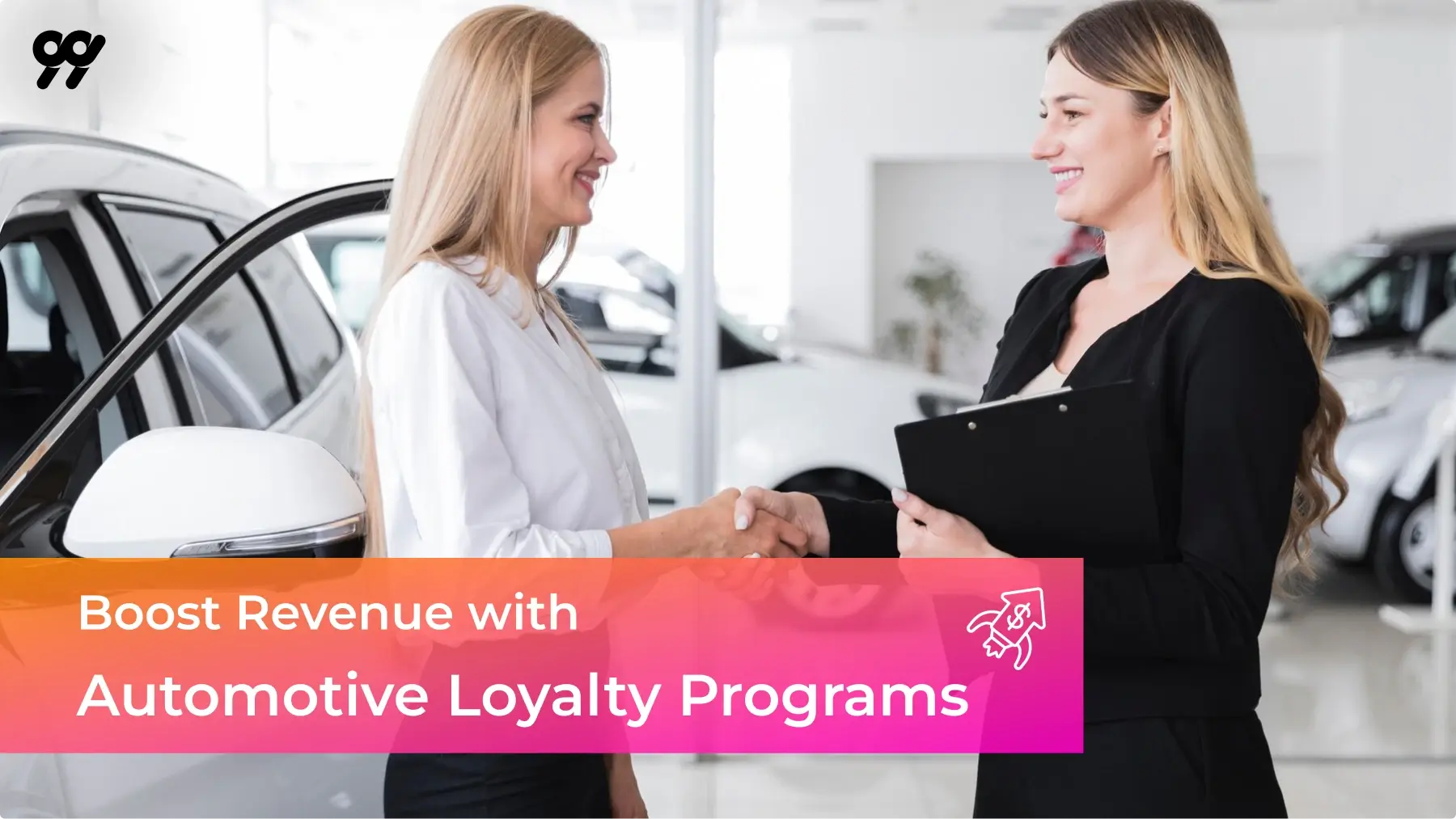
In today’s ultra-competitive automotive industry, customer loyalty isn’t just a nice-to-have—it’s a game-changer. With buyers facing endless options, brands that deliver more than just a great vehicle are the ones that stand out. That’s where automotive loyalty programs come into play. From reward points and service discounts to exclusive perks for long-term customers, these programs are designed to keep your buyers returning, not just for their next car, but for every oil change and tire rotation.
In this blog, we’ll explore why loyalty matters in the automotive world, what programs are most effective, and how forward-thinking dealerships and manufacturers use loyalty to drive growth and customer satisfaction.
Why Loyalty Matters in the Automotive Industry?
Let’s be honest—cars are expensive. Whether someone is buying their very first vehicle or upgrading to something flashier, that decision isn’t taken lightly. But what happens after the sale matters as much as the sale itself. And that’s where customer loyalty in the automotive world comes into play.
In today’s competitive landscape, car brands and dealerships can’t rely solely on price tags, horsepower, or flashy features to win customers. Sure, those things help seal the initial deal—but to keep customers coming back for regular servicing, future upgrades, or referring their friends, loyalty is the real engine that drives long-term success.
Whether you’re a dealership, a service center, or a manufacturer, fostering customer loyalty is more cost-effective than acquiring new buyers. It’s not just about rewards anymore—it’s about relationships.
What are Automotive Loyalty Programs?
Automotive loyalty programs are structured strategies to reward customers for engaging with a brand over time. These can take many forms, from earning points for routine maintenance to unlocking VIP experiences for loyal buyers.
Some programs focus on repeat servicing, while others include perks for referrals, car upgrades, app usage, or even just visiting a dealership’s website. The idea is simple: reward loyal behavior to boost retention and strengthen the customer-brand relationship.
But the best programs don’t just offer discounts. They create emotional connections and give customers a reason to choose one brand over the competition.
The Business Benefits of Automotive Loyalty Programs
Loyalty isn’t just a “nice to have” anymore—it’s a strategic business asset. Let’s look at some key reasons why:
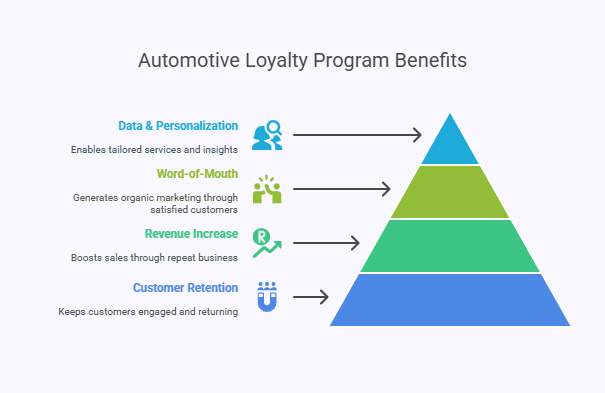
- Higher Customer Retention
Acquiring a new customer costs five times more than retaining an existing one. When loyalty programs are well-executed, customers return for service appointments, part upgrades, or even their next vehicle purchase.
- Increased Revenue
Repeat customers spend 33% more than new ones, especially when they trust the dealership. Loyal customers are far more likely to purchase service packages, accessories, and extended warranties.
- Free Word-of-Mouth Marketing
Loyal customers become brand advocates, recommending your service center or dealership to friends and family. This type of promotion is gold—and it’s free.
- Valuable Data & Personalization
Loyalty programs provide rich data about purchase behavior, service frequency, and preferences. This lets you create more personalized experiences and know what your customers want.
Types of Automotive Loyalty Programs
Not all dependability programs have made it to the rise. Here’s a breakdown of common sorts utilized within the car industry:
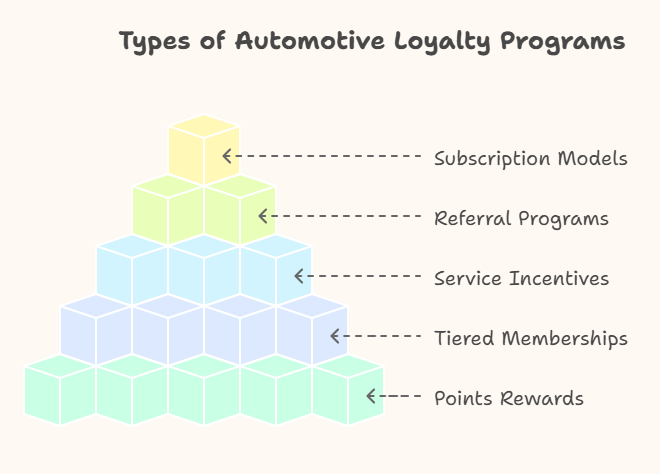
- Points-Based Rewards
This is the most common format. Customers earn points for every dollar spent on a car wash, oil change, or significant repair. Points can be redeemed for discounts, accessories, or even money off their next car.
Example: Earn 10 points per $1 spent. Redeem 1,000 points for a $50 discount on your next service.
- Tiered Memberships
These programs reward loyalty over time. Customers who spend more or engage more climb to higher tiers offering better perks, like early access to sales, priority service, or exclusive test-drive events.
Example: Silver, Gold, and Platinum tiers with increasing benefits.
- Service-Based Incentives
This structure rewards customers who stick with you for vehicle maintenance—oil changes, tire rotations, inspections, etc. It encourages routine servicing and builds trust with your service team.
Example: Get a free oil change after every five paid services.
- Referral Programs
Customers earn rewards for bringing in friends, family, or coworkers. These could be monetary, point-based, or include unique perks like event invites or bonus upgrades.
Example: Refer a friend and receive a $100 service credit.
- Subscription or Membership Models
Think of this like Netflix for car care. Customers pay a monthly or yearly fee for a package with a set number of oil changes, inspections, or detailing services. It’s convenient, budget-friendly, and keeps them coming back.
Example: $19.99/month for two oil changes a year, free tire rotation, and exclusive event invites.
Strategies to Design a Successful Loyalty Program
Creating a loyalty program isn’t just about handing out rewards—it’s about creating value and emotional connection at every step of the customer journey. A well-executed loyalty strategy can turn occasional buyers into brand advocates who return repeatedly, not just for purchases but for service, accessories, and even referrals.
Let’s dive into some actionable strategies that can help dealerships, service centers, or automotive brands build a loyalty program that genuinely resonates:
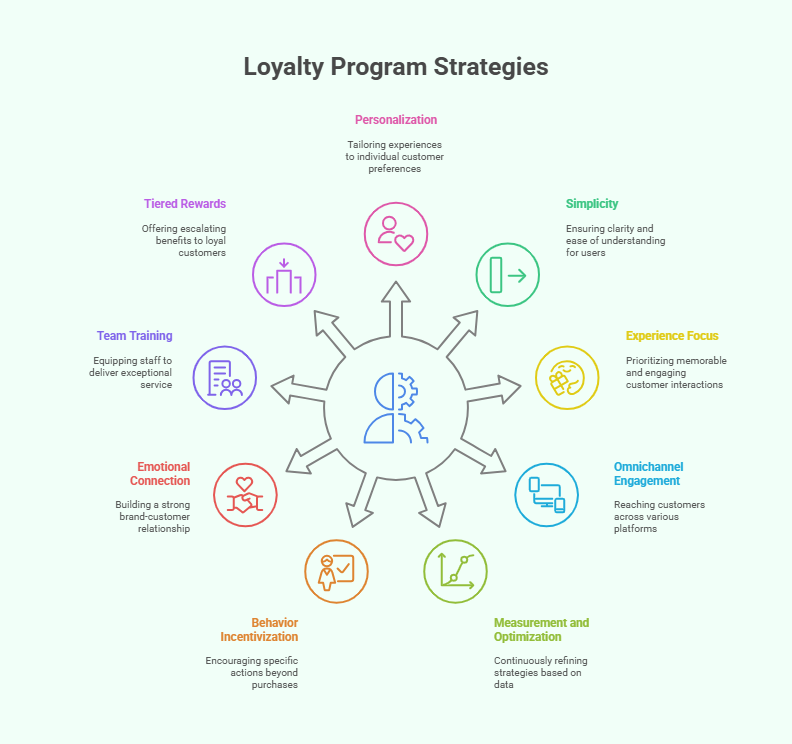
- Know Your Client—Personalize Like a Pro
Generic rewards don’t cut it anymore. Customers expect a tailored experience, especially when making high-consideration purchases like cars or committing to ongoing services.
Here’s how to do it:
- Segment your audience: Group customers using demographic data (age, location, vehicle type) and behavioral data (purchase history, service frequency).
- Use purchase triggers: Send service discounts when someone hits 5,000 miles or offer upgrade deals after 3 years of ownership.
- Targeted messaging: A luxury car buyer may appreciate an invitation to a VIP event, while a budget-conscious family might prefer a free oil change or tire rotation.
- Pro Tip: Leverage your CRM and POS systems to gather rich insights and automate personalized outreach.
- Keep It Simple—Clarity Wins Every Time
If your loyalty program feels like reading the terms and conditions of a loan contract, you’re losing customers before they even get started.
Best practices:
- Use simple, easy-to-understand language (avoid industry jargon).
- Clearly explain how points are earned and redeemed.
For example: “Earn 1 point per $1 spent. 500 points = $25 off your next service.”
Offer instant gratification where possible. A small, immediate reward (like a free car wash after a test drive) is more engaging than distant perks.
Remember: Convenience is king. If customers can’t figure it out in 30 seconds, they won’t bother.
- Focus on Experience—Go Beyond Discounts
Modern loyalty is more about how you make customers feel than just giving money off. Emotional engagement is a loyalty driver.
Ways to add experience-based perks:
- Invite long-term customers to exclusive preview events for new models.
- Offer “skip-the-line” express service appointments or free vehicle pick-up/drop-off.
- Provide branded merchandise, birthday surprises, or anniversary gifts (like a small voucher on the anniversary of their purchase).
Example: Tesla’s referral program previously offered rewards like invitations to product unveilings and
VIP factory tours—experiences money can’t buy.
- Omnichannel Engagement—Meet Them Where They Are
Your customers live online and offline. Your loyalty program should, too.
Key elements:
- Allow customers to earn points whether they visit the dealership, buy accessories online, or engage on social media.
- Develop a mobile app or integrate with digital wallets so customers can track their points, schedule services, and receive push notifications.
- Use QR codes in physical locations that let customers check in, scan service invoices, or access exclusive offers.
Modern must-have: Integration with connected car technology and infotainment systems can push loyalty to the next level.
- Measure and Optimize—Loyalty is Never 'Set and Forget'
You must track performance metrics to ensure your loyalty program drives the desired behaviors and tweak things when necessary.
What to measure:
- Redemption rates: Are customers using their rewards, or will they waste them?
- Repeat visit frequency: Are loyalty members returning for more services or upgrades?
- Customer Lifetime Value (CLV): Has it increased for loyalty program members?
- Referral metrics: How many new customers are coming from existing ones?
Use this data to refine rewards, eliminate friction points, and personalize offerings more effectively. Testing different versions of your program (A/B testing) can also reveal what resonates.
- Incentivize Desired Behaviors—More Than Just Purchases
Think broader than “buy a car, get points.” The best loyalty programs reward engagement throughout the lifecycle.
Ideas to incentivize:
- Award points for completing surveys or writing reviews.
- Give bonuses for social media shares or attending showroom events.
- Offer a “birthday bonus” or seasonal promotions to drive timely engagement.
Example: Offer 100 bonus points to members who refer a friend and another 100 when the friend makes their first service visit.
- Make It Emotional—Create a Brand Connection
It’s easy to copy discounts. It’s hard to copy emotional connections. Make your brand more than just a business—it should feel like a community.
Here’s how to build that connection:
- Spotlight loyal customers on your website or in newsletters.
- Celebrate milestones: 1st anniversary of car ownership, 100,000 miles driven, etc.
- Create an elite tier for “super fans” with surprise perks like hand-written thank-you notes or personalized car care kits.
The goal? Build a relationship that goes beyond the transactional. Let your customers feel seen and appreciated.
- Train Your Team—Loyalty Starts at the Front Line
Even the best-designed program can fail if your staff doesn’t promote it effectively.
Training checklist:
- Ensure sales and service teams are well-versed in how the program works.
- Equip staff with ready-to-go scripts or talking points to explain benefits to customers.
- Incentivize your employees to enroll customers or hit loyalty-related KPIs.
- Employees are your brand ambassadors—make sure they believe in and support the loyalty experience.
- Tiered Rewards—Make Loyalty Aspirational
Adding tiers (e.g., Silver, Gold, Platinum) motivates customers to engage more often to reach the next level.
Example Tier System:
- Silver: Basic benefits like service discounts.
- Gold: Priority booking, extended warranties, and early access to sales.
- Platinum: Free annual vehicle inspection, VIP events, concierge service, and travel vouchers.
- Tiered programs tap into the psychology of progression. Everyone loves “unlocking” perks.
Examples of Effective Automotive Loyalty Programs
- Toyota Rewards
Toyota offers a comprehensive program where customers earn points for purchases and services, which they can redeem for future maintenance or accessories. It’s a well-rounded, easy-to-understand system that encourages continued patronage.
- Nissan One To One Rewards
Nissan’s efforts in terms of unwavering quality are related to after-sales. Clients get credit for all pickups as they procure a maker they like. It’s a pleasant way to make clients think they’re returning to commerce as usual.
- FordPass Rewards
Fodpass is a mobile dedication program that supports guard planning, car purchases, and connecting with apps. The use of computer-aided tools promotes long-term commitment.
Challenges in Implementing Loyalty Programs and How to Overcome Them
While loyalty programs offer great benefits, they aren’t without challenges:

- Low Participation: Customers may not see enough value. Fix this by offering instant rewards or sign-up bonuses.
- Complexity: Programs with too many rules confuse customers. Simplify the structure and communicate benefits.
- Data Silos: Loyalty data needs to integrate with your CRM, POS, and marketing systems. Invest in proper infrastructure.
- Lack of Personalization: One-size-fits-all rewards don’t excite modern consumers. Use data to personalize rewards and messaging.
The Role of Technology in Automotive Loyalty
Technological innovation is the cornerstone of contemporary loyalty programs. Automotive brands can utilize AI, machine learning, and CRM integration to:
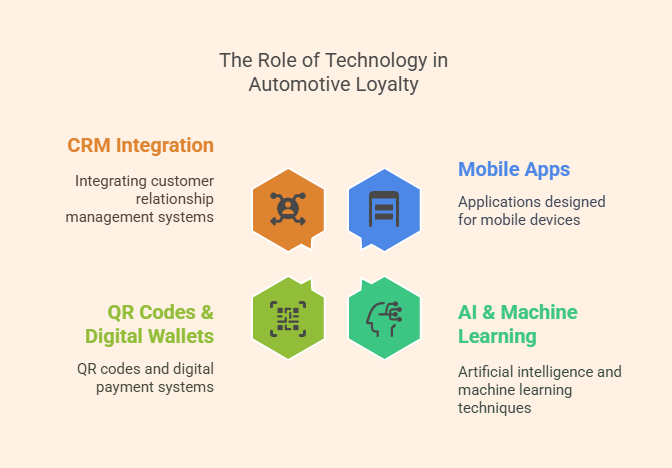
- Mobile Apps: Make it easy for customers to track rewards, schedule service, or get notifications.
- AI & Machine Learning: Predict customer needs, send personalized offers, and recommend timely services.
- QR Codes & Digital Wallets: Offer frictionless sign-ins and redemptions at the point of service.
- CRM Integration: Combine loyalty data with purchase history, preferences, and more to deliver tailored experiences.
With mobile apps, QR codes, and digital wallets, customers can more easily partake, monitor progress, and redeem rewards regardless of location.
Future Trends in Automotive Loyalty Programs
Looking ahead, loyalty programs in the automotive industry will become:
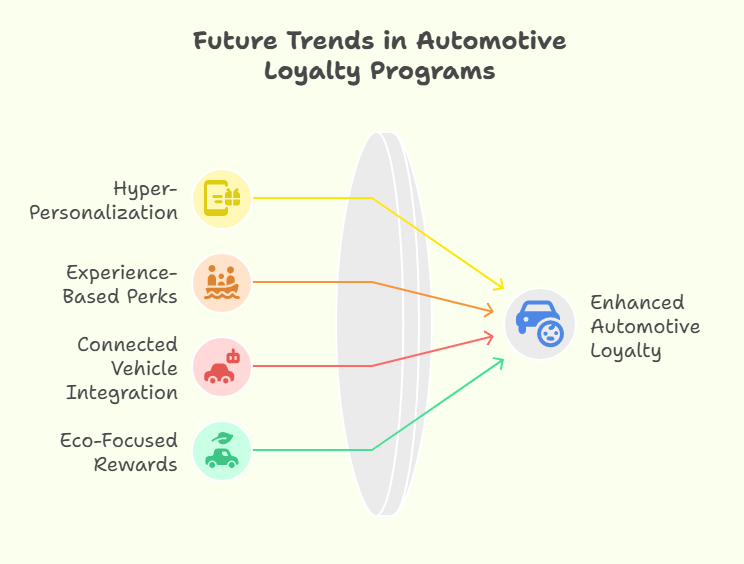
- Hyper-Personalization
Using real-time behavior and data, programs will offer even more tailored rewards—like discounts on your next EV battery replacement or free charging credits.
- Experience-Based Perks
Think beyond discounts. Expect more unique experiences like track days, factory tours, or private events for top-tier members.
- Connected Vehicle Integration
Loyalty programs could soon be integrated directly into your vehicle’s infotainment system, sending reminders or alerts about point balances, special offers, or service needs.
- Eco-Focused Rewards
With sustainability becoming a priority, brands may start rewarding customers for eco-friendly actions like maintaining EVs, driving hybrids, or participating in recycling programs.
Conclusion
As the automotive industry evolves toward a more connected and customer-centric future, loyalty programs have become a strategic necessity. Modern car buyers are digitally savvy and value long-term relationships with their chosen brands. To meet these expectations, leading automotive companies are designing loyalty programs beyond traditional offerings—integrating personalization, seamless digital engagement, and exclusive services that genuinely resonate with their customers.
A well-executed loyalty program doesn’t just encourage repeat visits; it fosters emotional connections and lasting trust. These programs provide tangible value, from points earned on service appointments to early access to new vehicle launches or complimentary roadside assistance. With rising acquisition costs and intense market competition, retaining existing customers—often five times more cost-effective than acquiring new ones—presents a compelling business case for every brand in the industry.
Whether you’re a dealership, OEM, or service center, now is the time to invest in loyalty strategies that emphasize long-term engagement. With advanced technologies like CRM systems, mobile apps, and AI-powered insights, loyalty programs are more dynamic and scalable than ever.
That’s where platforms like 99minds come in—offering flexible, data-driven loyalty solutions tailored for the automotive world. Whether you want to reward service visits, personalize incentives, or roll out referral campaigns, 99minds empowers brands to create deeper, more meaningful relationships with their customers. Ultimately, it’s not just about selling more vehicles—it’s about building loyalty that drives lifetime value.
Frequently-Ask-Questions-(FAQs)-on-Automotive-Loyalty-Programs
What makes a good automotive loyalty program?
A good program is simple to use, offers relevant rewards, and integrates with the customer's journey. It should also be backed by data and regularly optimized.
Are loyalty programs only for dealerships?
Not at all. Manufacturers, service centers, and even parts retailers can all benefit from launching loyalty initiatives.
How can I measure the ROI of a loyalty program?
Track metrics like customer retention rate, average spend per customer, repeat visit frequency, and referral activity. Combine this with qualitative feedback to understand overall impact.
Do loyalty programs work for used car dealerships?
Yes. In fact, used car buyers often become highly loyal customers when offered valuable service-based rewards and personalized communication.









